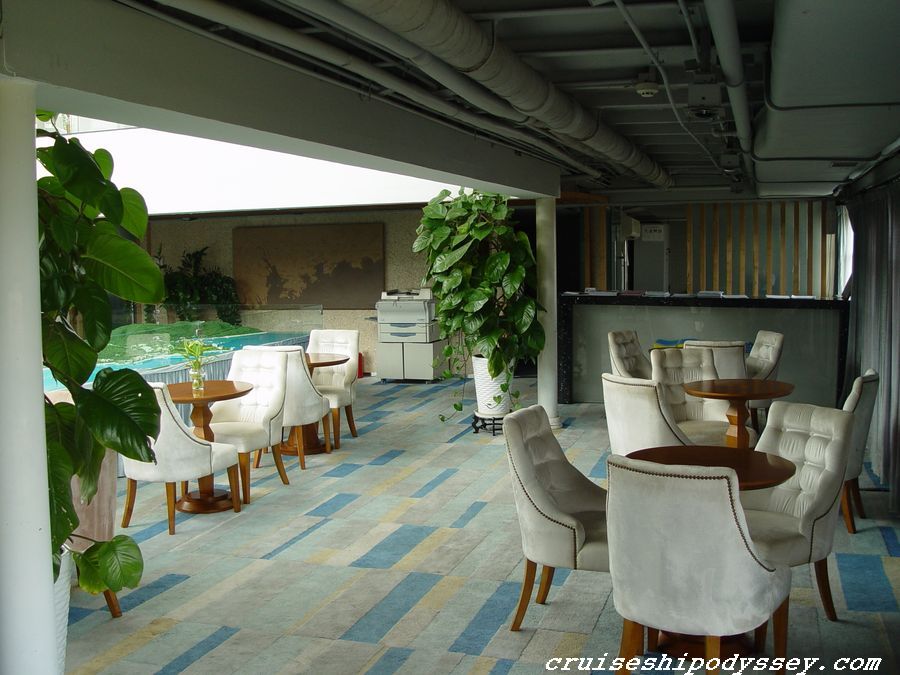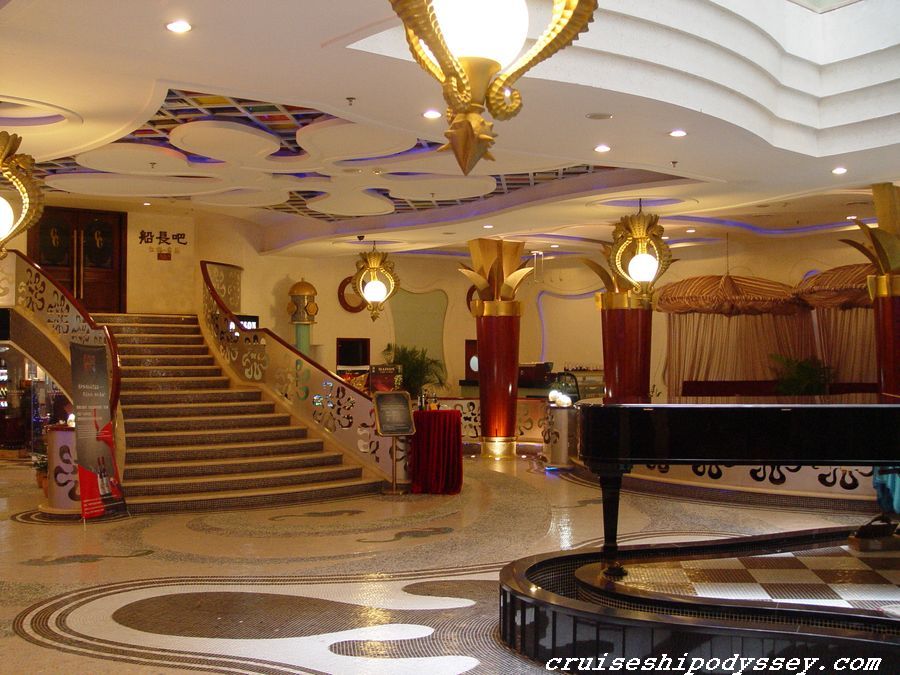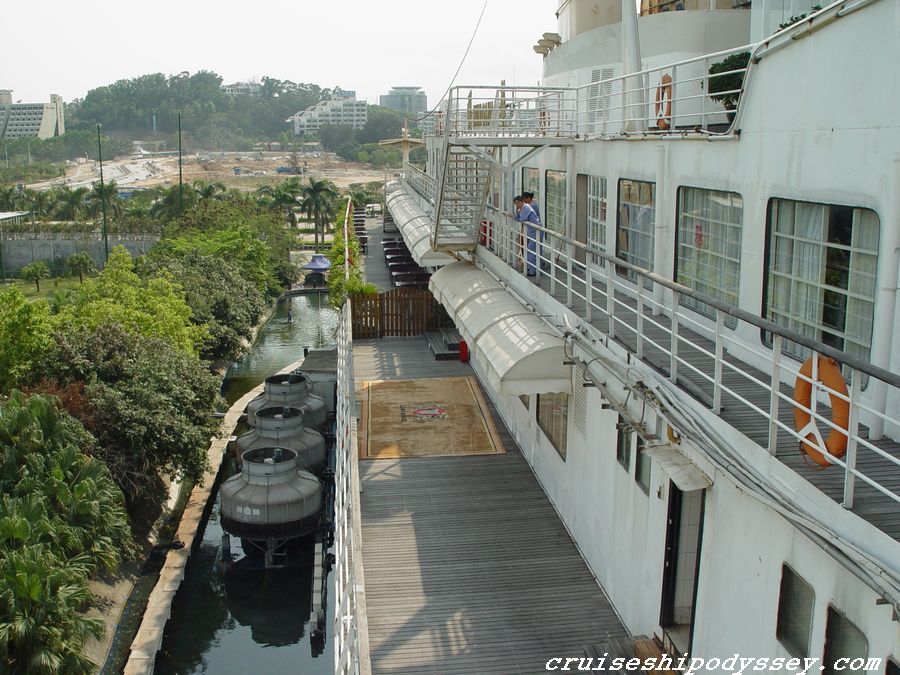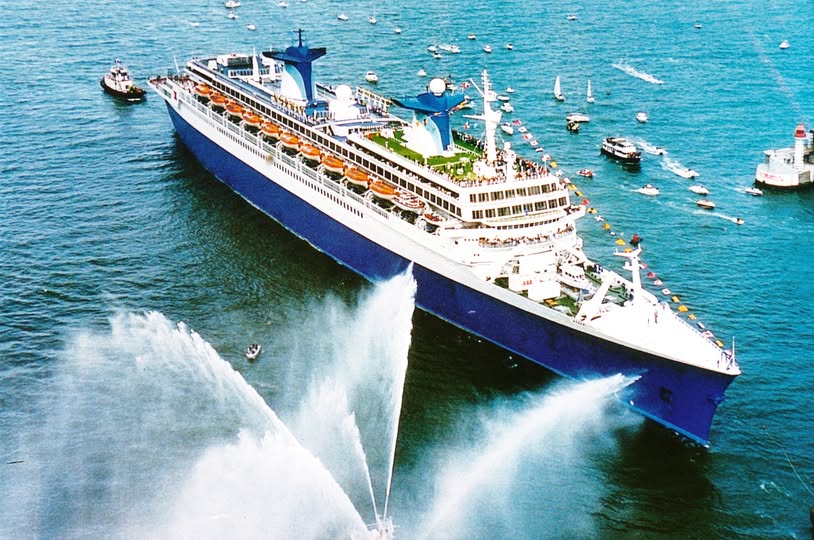Interior photographs of Minghua, ex-Ancerville in her current role at Sea World in Shenzhen, China here
Compagnie de Navigation Paquet (CNP) approaching the end of its existence, still had the courage to order a newbuilding from the Chantiers de l’Atlantique shipyard in St. Nazaire, their first from this yard, even while prospects for the near future of liner services were not looking good at all. She was to be primarily a liner, but designed with cruising in mind also. It would take until the 1980’s however for cruising to become popular in France, so as an alternative to liner service it wasn’t a viable option yet at the time. Construction started in April 1960, she was launched and named Ancerville by Charles de Gaulle on April 5, 1962, Ancerville being the city where the founder of CNP, Nicolas Piquet was born. She left St. Nazaire in August for her homeport Marseille.
She began her career with an inaugural cruise in September 1962 to the eastern Mediterranean, and then started service between France, Marocco, the Canary Islands and Senegal, sailing in tandem with CNP’s Lyautey. Ancerville, 168 meters long 22 meters wide and with a draught of 6.5 meters was a fast ship, she had done 24.4 knots during her trials and her 26,700hp strong 12-cylinder Burmeister & Wain turbo charged diesel engines enabled her to reach Casablanca in well under 2 days and Dakar in 4 days from Marseille.

However, this was not enough to be able to compete with the aeroplane and critics of the first hour who had been of the opinion that she should not have been ordered at all were more and more proven right. The same happened to France’s ship of state, the France of 1962 which had to be heavy subsidized to continue operating her transatlantic service, resulting in her being taken out of service in 1974. The modern looking Ancerville -her yacht-like design clearly was a departure from the classic liner exterior and would be repeated with the construction of her near sister Renaissance (1966) – carried 780 passengers as well as 180 crew on liner voyages. Ancerville was a three-class vessel, she carried 171 passengers in first class, 342 in second and 243 in third class. Her cheapest accommodation were cabins and dormitories for 4 to 10 passengers. A novelty during those days, all cabins and dormitories were situated in the forward part of the ship, apart from the theatre and the chapel, all public spaces were located aft.

She was equipped with stabilizers, had three heated pools and even TV-sets onboard, which sadly only worked within 50 km’s from shore, as the satellite-era still had to begin. In the 1960’s CNP had already started to operate occaisonal cruises to generate additional income with its fleet of four passenger ships. Ancerville sailed on 13-day cruises from Marseille to Madeira, the Canary Islands and Casablanca. Simultaneously, her liner service to Marocco and Senegal was gradually phased out. In 1970 CNP was forced to sell Ancerville to the Nouvelle Compgnie de Paquebots, which left her on her familiar route with some cruising in between. So for Ancerville not much changed, although she switched to cruising more and more, to Alicante, Madeira, Tanger and the Canaries, but also to West Africa and even South America. A refit had changed her into a single class 500 passenger cruise ship, her cabins were redecorated . In 1970, she had her moment of fame when she rescued 720 passengers from the burning Costa liner Fulvia near the Canary Islands. But the curtain fell definitely in 1973 when she changed hands again, this time to the Peoples Republic of China, with the China Ocean Shipping Company (COSCO) being her new owners.
Her hull was painted a pale green, her funnels yellow with a red band which contained at gold star with three stylised waves on either side of it.

Renamed Minghua meaning “Spirit of China”, she briefly operated liner voyages from China to the east coast of Africa before serving as a floating hotel in Dar es Salam, Tanzania for the Chinese labour force working on the construction of the Tanzara (Tanzania Zambia Railway Authority) railway. After a refit in 1980 in Hong Kong where she was upgraded to meet new safety rules she started cruising, manned by 190 crew looking after 580 passengers and flying the Chinese flag. She was charted by the Asian Pacific Cruises company but after a disagreement between owner and charterer this already ended after two cruises. Now Burns Philp, a well know Australian shipping agent since the 1880’s stepped in, They marketed her under the banner of Minghua Friendship – cruises. Minghua was refitted again, foremost her interiors and her hull reverted to all white again. She became very popular with the Australians, sailing in Asian and South Pacific waters as far as Hawaii. Although she seemed profitable, she was suddenly withdrawn in 1983 without any obvious reason.
In 1978, Minghua evacuated Chinese citizens living in Vietnam because of growing tensions between both countries. The Vietnamese refused Minghua to dock and lengthy negotiations followed. After several weeks Mingua returned to China without refugees.

In May 1979 the Minghua departed on a four week voyage to Japan with a Chinese goodwill delegation of 600 people on board led by General Liao Chengzhi, the President of the China-Japan Friendship Association to improve relations between the two countries. The Minghua spent a month cruising around Japan.
She was now laid up in China. After being sold to Sea World Ltd. In June 1984, Minghua became a floating hotel at Sheku, near Shenzhen, where she is part of Sheku Sea World, still showing the name of Minghua on her hull as part of an economic zone designated to be developed for local tourism. China’s leader Dan Xiaoping once stayed aboard in cabin 125 to open her. It was immediately painstakingly preserved. Disaster struck in 1998 when she suffered a curious fire. Rebuilt until 2005 and re-emerging as a 4-star 253-room hotel with several Chinese and Western bars and restaurants as well as a dance hall. They were accessible through the ships port side which was opened up at various locations to provide entrance. She still survives, without her lifeboats and davits and with her portholes being replaced by four rows of large windows on each side. Minghua nowadays is completely landlocked between a golf course, park, shops, bars and restaurants.

Reconstructing the ship for her stationary role took a long time, until 2004 before work was finally completed. A monster wave of four meters high after heavy rainfall in 2007 caused extensive damage and it took until 2009 until repairs had been finalised.

I visited her in 2010, it took a long taxi ride through Shenzhen, having obtained a day pass for entering China from Hong Kong where I stayed. After having arrived finally at Sheku Sea World, I paid the taxi driver who immediately exploded. I couldn’t understand a word he was saying so I took him to a Thomas Cook travel agent across the street. There I was told that when changing money at the border, I had been given counterfeit bills. I was relieved when he understood and left without warning the police, otherwise I would have been in very deep trouble! When returning to Hong Kong that night, still furious, I forced myself to walk pass the exhange office and don’t do anything foolish…

She remains a bit of a mystery ship nowadays as apart from the interior pictures on Cruiseshipodyssey.com and some exterior photographs on the internet, there does not seem to be much known about her presently. Fortunately she has been preserved and although now largely rebuilt, but with her profile being mostly unchanged, there is still more than enough left of her to be enjoyed in her new role .


